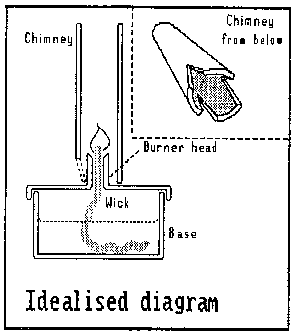Bunsen Substitute
A SIMPLE, SMOKELESS KEROSENE BURNER FOR SCHOOLS
REQUIREMENTS
Base A solid container for kerosene or similar fuel oil, capable of supporting the burner head and chimney.
Burner Head Combines the functions of lid for the base, support for the wick and support for the chimney. The wick must be held higher than in a comparable spirit burner to allow access for air through the chimney below the flame.
Chimney A cylinder with large notches in the lower rim to admit air; wide enough to leave a quarter-inch (roughly 5 mm) gap between inner wall and flame.
Wick Preferably purpose-made, but any suitably absorbent fabric will do. It must provide an adequate flow of fuel for the particular application.
A basic requirement for practical science education is a means of applying localised heat. In third-world countries, such luxuries as gas supplies and Bunsen burners are not generally available, and spirit or kerosene burners are the only practicable alternatives: even these may have to be home-made. Methylated spirit, if available, is relatively expensive, while normal kerosene burners give a smoky flame that leaves a deposit of soot on apparatus. The modification described here, however, gives a smoke-free flame, and is simple enough to be easily made by teachers or indeed by children themselves.
Its operation depends on a chimney to which air is admitted BELOW THE FLAME. This chimney is essentially a cylinder, wide enough to allow a clearance of about 5 mm or a quarter-inch between flame and wall, and tall enough for combustion to be complete within it. Two or three deep notches in the lower rim serve as ventilation inlets, and must be large enough to allow an adequate flow of air without unduly diluting the hot emerging gases. The actual dimensions will thus depend on the size of the flame, and so on the size and texture of the wick, and are themselves a fit topic for experiment.
The highly-idealised diagram above shows the essentials of construction, which in practice can without disadvantage be very crude. The prototype was made from a small bottle as base, with the burner head and chimney formed from a plaster-based filling compound. A lower, squatter base would be more stable and convenient in use.
The plaster compound was not wholly satisfactory either, particularly for the burner head where its porosity allowed fuel to spread from the wick, and where dehydration caused the tip to crumble. Potter’s clay would almost certainly be better, but any heat-resisting material capable of being moulded while soft and subsequently setting fairly hard could be used, preferably with a foil liner around the wick to prevent fuel from spreading outwards. Because of the need to handle the chimney when hot, and to avoid undue heat losses in use, it would be best not to use any highly-conducting material such as metal for it.
In the prototype the head was moulded round the neck of the bottle, with a ballpoint refill through it to form the wick channel. The chimney was shaped as a rough cylinder, about 12 cm (5 inches) high, by rolling out the material into a sheet and forming it round a rolled-up page from a magazine, later removed. The notches at the base were started while the material was soft, and carved out to the final shape with a penknife after setting.
In case all this detail seems daunting, the prototype was made by pure guesswork, and worked first time.
Peter Wilson, Seascale, Cumbria, UK; October 1988.
Copyright on text © 2001, 2016
